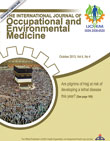فهرست مطالب

International Journal of Occupational and Environmental Medicine
Volume:4 Issue: 4, Oct 2013
- تاریخ انتشار: 1392/08/08
- تعداد عناوین: 11
-
-
Page 1
-
Page 10
-
Page 172BackgroundAwareness of occupational hazards and its safety precautions among welders is an important health issue, especially in developing countries.ObjectiveTo assess the awareness of occupational hazards and utilization of safety measures among welders in coastal South India.MethodsA cross-sectional study was conducted among 209 welders in Puducherry, South India. Baseline characteristics, awareness of health hazards, safety measures and their availability to and utilization by the participants were assessed using a pre-tested structured questionnaire.ResultsThe majority of studied welders aged between 20 and 40 years (n=160, 76.6%) and had 1-10 years of education (n=181, 86.6%). They were more aware of hazards (n=174, 83.3%) than safety measures (n=134, 64.1%). The majority of studied welders utilized at least one protective measure in the preceding week (n=200, 95.7%). Many of them had more than 5 years of experience (n=175, 83.7%), however, only 20% of them had institutional training (n=40, 19.1%). Age group, education level, and utilization of safety measures were significantly associated with awareness of hazards in univariate analysis (p<0.05).ConclusionAwareness of occupational hazards and utilization of safety measures is low among welders in coastal South India, which highlights the importance of strengthening safety regulatory services towards this group of workers.
-
Page 178BackgroundIn India, for the high concentration of fluoride in groundwater, people are at risk of dental fluorosis. The problem is common in various states of India. The condition in Rajasthan is worse where all districts have such a problem.ObjectiveTo study the fluoride concentration in groundwater and prevalence of dental fluorosis in Didwana block of Nagaur district, Central Rajasthan, India.MethodsThe fluoride concentration in water of 54 villages was measured electrochemically, using fluoride ion selective electrode. Dental fluorosis was assessed in 1136 people residing in study area by Dean''s classification for dental fluorosis.ResultsThe fluoride concentration in groundwater in studied sites ranged from 0.5 to 8.5 mg/L. The concentration of fluoride was more than the maximum permissible limit set by WHO and Bureau of Indian Standards (1 mg/L) in 48 groundwater sources. Of 1136 people studied, 788 (69.4%; 95% CI: 66.7%–72.1%) had dental fluorosis—252 had mild and 74 had severe dental fluorosis.ConclusionHigh level of fluoride in drinking water of Didwana block of Nagaur district, Central Rajasthan, India, causes dental fluorosis in most people in the region and is an important health problem that needs prompt attention.
-
Page 185BackgroundPost-traumatic stress disorder (PTSD) is an anxiety disorder that may develop following a trauma. Iranian commercial motor vehicle drivers experience many road traffic accidents during their working life; this may increase the probability for developing PTSD, which in turn may lead to increased human errors as well as decreased work efficiency.ObjectiveTo examine the prevalence of PTSD and its associated factors among a group of Iranian commercial motor vehicle drivers.MethodsIn a cross-sectional study, 424 drivers who referred to participate in an annually training program were selected using a simple random sampling technique. They were requested to complete the Persian version of PCL-C and a data collection sheet about their occupational and demographic features.Results385 (90.8%) of 424 studied drivers completed the study. 265 (68.8%) of the drivers had first-grade driving license. The mean±SD on-the-job daily driving was 10.2±2.8 h. 74 of 385 (19.2%; 95% CI: 15.3%–23.2%) met the PTSD criteria. Higher age and job experience as a professional driver, and having past history or past familial history of psychiatric disorders, were independent predictors of developing PTSD. The disease was more prevalent among drivers with first-grade driving license.ConclusionThe prevalence of PTSD among Iranian commercial motor vehicle drivers is higher than the figures reported elsewhere. Measures to diagnose of such drivers and to ensure optimum follow-up of victims before return to professional driving should be considered.
-
Page 195BackgroundWork-related musculoskeletal disorders (WMSDs) are a common health problem throughout the world and a major cause of disability in the workplace.ObjectiveTo determine the prevalence rate of MSDs, assessment of ergonomics working conditions and identification of major risk factors associated with MSDs symptoms among employees of Iranian petrochemical industries between October 2009 and December 2012.MethodsIn this study, we studied 1184 randomly selected employees of 4 Iranian petrochemical companies with at least one year of work experience in office or operational units. For those with office jobs, data were collected using Nordic Musculoskeletal disorders Questionnaire (NMQ) and ergonomics checklist for the assessment of working conditions. For those with operational jobs, NMQ and Quick Exposure Check (QEC) method were used for data collection.ResultsThe most prevalent MSD symptoms were reported in lower back (41.5%) and neck (36.5%). The prevalence of MSDs in all body regions but elbows and thighs of the office staff was significantly higher than that of operational workers. Assessment of working conditions in office staff revealed that the lowest index was attributed to workstation. QEC technique among operational workers showed that in 73.8% of the workers studied, the level of exposure to musculoskeletal risks was “high” or “very high.” MSDs were associated with type of job, age, body mass index, work experience, gender, marital status, educational level and type of employment.ConclusionThe prevalence of MSDs in the office staff was higher than that of operational workers. Level of exposure to MSDs risk was high in operational workers. Corrective measures are thus necessary for improving working conditions for both office and operational units.
-
Page 205BackgroundOccupational accidents are one of the major health hazards in industries and associated with high mortality, morbidity, spiritual damage and economic losses in the world.ObjectiveTo determine the incidence of occupational accidents in 9 Iranian gas refineries between March 2007 and February 2011.MethodsData on all occupational accidents occurred between March 2007 and February 2011, as well as other possible associated variables including time of accident, whether the accident was due to a personal or systemic fault, type of accident and its outcomes, age and gender of the victim, the injured parts of the body, job experience, and type of employment, were extracted from HSE reports and notes of health care services. Based on these data, we calculated the incidence rate of accidents and assessed the associated factors.ResultsDuring the 5 studied years, 1129 accidents have been recorded. The incidence of fatal accidents was 1.64 per 100 000 and of nonfatal accidents was 1857 per 100 000 workers per year. 99.4% of injured workers were male. The mean±SD age of injured people was 29.6±7.3 years. Almost 70% of injured workers aged under 30 years. The mean±SD job experience was 5.3±5.3 years. Accidents occurred more commonly around 10:00. More than 60% of accidents happened between 8:00 and 15:00. July had the highest incidence rate. The most common type of accident was being struck by an object (48%). More than 94% of accidents are caused by personal rather than systemic faults. Hands and wrists were the most common injured parts and involved in more than one-third of accidents. 70% of injured workers needed medical treatment and returned to work after primary treatment.ConclusionThe pattern of occupational accidents in Iranian gas refineries is similar to other previous reports in many ways. The incidence did not change significantly over the study period. Establishment of an online network for precise registration, notification and meticulous data collection seems necessary.
-
Page 211Capsaicin causes direct irritation of the eyes, mucous membranes, and respiratory tract. It is used in self-defense, in crowd control, and as a less lethal weapon in police work. Controlled trials suggest that capsaicin has minimal serious acute effects. Herein, we report a woman who had a 20-minute exposure to capsaicin during a jail riot. She subsequently developed episodic dyspnea and cough, and increased sensitivity to scents, perfumes, and cigarette smoke. She has not had wheezes on physical examination or abnormal pulmonary function tests. Her response to inhaled steroids and long-acting beta-agonists has been incomplete. She appears to have developed airway sensory hyperreactivity syndrome after the inhalation of capsaicin, which likely injured sensory nerves and/or caused persistent neurogenic inflammation.


